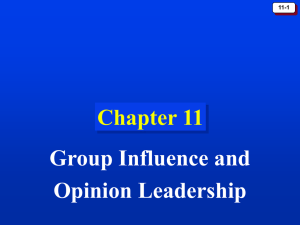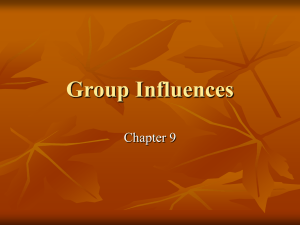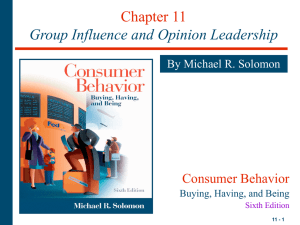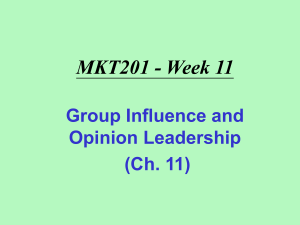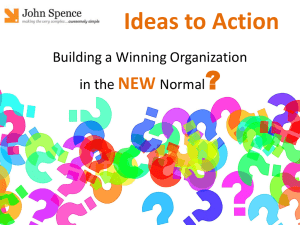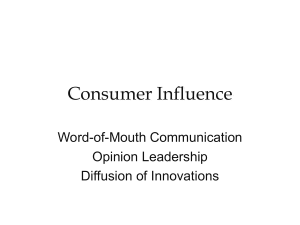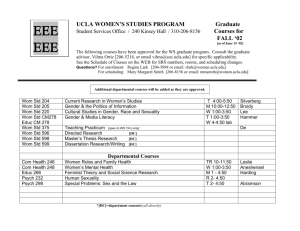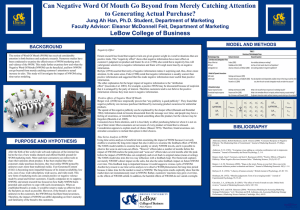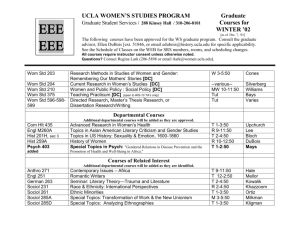Word of Mouth Process: Your Way to Sales Success
advertisement
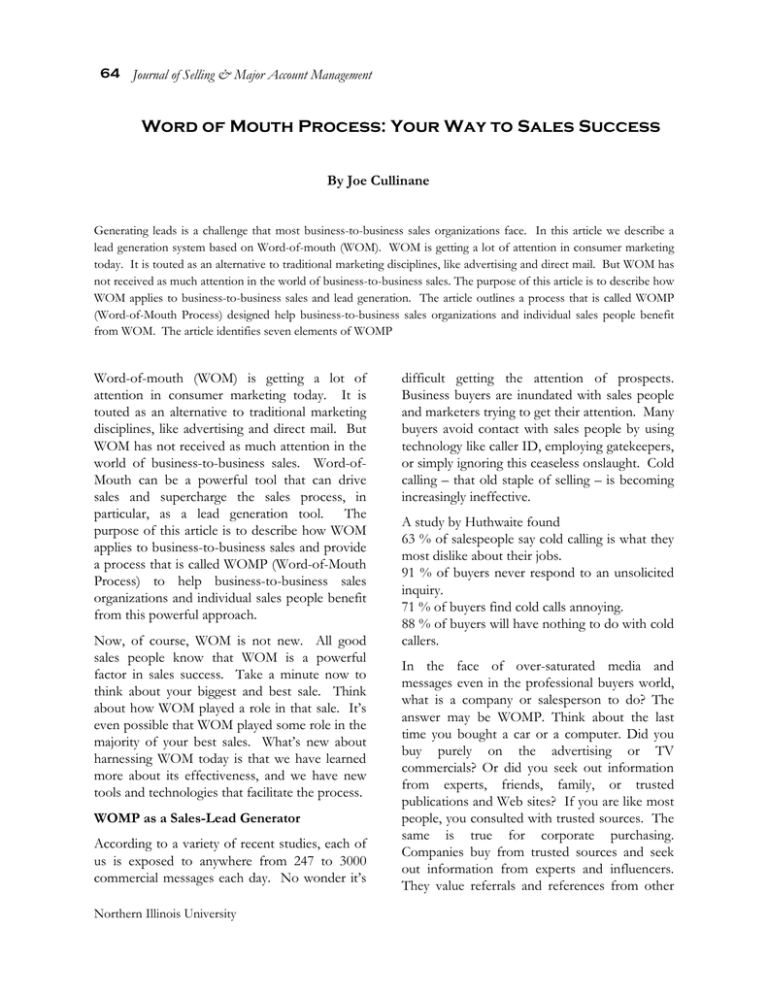
64 Journal of Selling & Major Account Management Word of Mouth Process: Your Way to Sales Success By Joe Cullinane Generating leads is a challenge that most business-to-business sales organizations face. In this article we describe a lead generation system based on Word-of-mouth (WOM). WOM is getting a lot of attention in consumer marketing today. It is touted as an alternative to traditional marketing disciplines, like advertising and direct mail. But WOM has not received as much attention in the world of business-to-business sales. The purpose of this article is to describe how WOM applies to business-to-business sales and lead generation. The article outlines a process that is called WOMP (Word-of-Mouth Process) designed help business-to-business sales organizations and individual sales people benefit from WOM. The article identifies seven elements of WOMP Word-of-mouth (WOM) is getting a lot of attention in consumer marketing today. It is touted as an alternative to traditional marketing disciplines, like advertising and direct mail. But WOM has not received as much attention in the world of business-to-business sales. Word-ofMouth can be a powerful tool that can drive sales and supercharge the sales process, in particular, as a lead generation tool. The purpose of this article is to describe how WOM applies to business-to-business sales and provide a process that is called WOMP (Word-of-Mouth Process) to help business-to-business sales organizations and individual sales people benefit from this powerful approach. Now, of course, WOM is not new. All good sales people know that WOM is a powerful factor in sales success. Take a minute now to think about your biggest and best sale. Think about how WOM played a role in that sale. It’s even possible that WOM played some role in the majority of your best sales. What’s new about harnessing WOM today is that we have learned more about its effectiveness, and we have new tools and technologies that facilitate the process. WOMP as a Sales-Lead Generator According to a variety of recent studies, each of us is exposed to anywhere from 247 to 3000 commercial messages each day. No wonder it’s Northern Illinois University difficult getting the attention of prospects. Business buyers are inundated with sales people and marketers trying to get their attention. Many buyers avoid contact with sales people by using technology like caller ID, employing gatekeepers, or simply ignoring this ceaseless onslaught. Cold calling – that old staple of selling – is becoming increasingly ineffective. A study by Huthwaite found 63 % of salespeople say cold calling is what they most dislike about their jobs. 91 % of buyers never respond to an unsolicited inquiry. 71 % of buyers find cold calls annoying. 88 % of buyers will have nothing to do with cold callers. In the face of over-saturated media and messages even in the professional buyers world, what is a company or salesperson to do? The answer may be WOMP. Think about the last time you bought a car or a computer. Did you buy purely on the advertising or TV commercials? Or did you seek out information from experts, friends, family, or trusted publications and Web sites? If you are like most people, you consulted with trusted sources. The same is true for corporate purchasing. Companies buy from trusted sources and seek out information from experts and influencers. They value referrals and references from other Application Article 65 Winter 2006 companies in their field. WOMP’s Seven Steps Despite WOMP’s advantages, most sales people would tell you that they do not use it purposefully or effectively. The reason is that they do not have or understand the system. The Word of Mouth Process or WOMP is a system that anyone can use to harness the power of word of mouth. Although it’s a simple concept, a number of crucial factors give word-of-mouth its tremendous power. Follow these seven steps of WOMP to harness the power of word-of-mouth and generate new business-to-business leads. It All Starts With A WOMP Story If you want to create favorable word of mouth about yourself, company, and/or products, you have to give people something to talk about. The way to accomplish this is to create a “WOMP story.” Humans have used stories to communicate since ancient times. Rhetorical scholar Walter Fisher’s narrative theory explains how we as humans communicate by taking complicated information and transforming it into narrative stories. For example, when Fed Ex first started their service, it seemed miraculous that a company could actually get a package anywhere overnight. Early users were quite evangelistic about Fed-Ex – seems like everyone had a favorite “Fed Ex story” to tell about how Fed Ex saved the day. Success stories like these make it easy for the customers to relate to the benefits of a product and are far more effective than simply stating features and functions. Here are some things to consider when creating your WOMP story. 1. What’s unique and different about you, your company, and/or product that’s worth talking about from the customer perspective? 2. What’s remarkable about what you are doing that will stimulate WOM? 3. What’s the valuable proposition you wish to convey? What problem do you solve? 4. What’s your elevator pitch? Your 30 second story? 5. How will you disseminate your message; e.g., e-mail, telephone, blogs, publicity, etc.? 1. Leverage Influentially. “In times of change, people naturally seek a guide, someone who's been ahead of them, who's already identified the issues, addressed them in his or her own life, and can offer good, reliable, informed insights, advice, information about what's going on now and what's to come, someone they trust. Americans are placing increasing stock in the simplest form of communication, word-of-mouth advice and information from people they know and trust.” Ed Keller and Jon Berry, The Influentials In their book, The Influentials, Ed Keller and Jon Berry point out that one person in ten influences the other nine. These people can be analysts, columnists or experts. For example, I will not make a technology decision without conferring with Roger Green, a former CIO. Get your message across to the Rogers of the world. Find out where they go for information, what do they read? What Web sites do they visit? Identify the influential people in your industry and put together a strategy to get them talking about your product or service. Send them a free copy of your software, forward favorable articles or reviews. Do you know someone who can introduce you to the right Influentials? Every buying organization has an “Influential” or “a go to person” for your product area. In Enterprise software sales it was the systems programmer. The systems programmer is highly respected for their technical knowledge and often influence the CIO’s decisions. Even if the system programmer was not involved in the use of the product, his or her endorsement had a big impact in the sale. Vol. 6, No. 1 66 Journal of Selling & Major Account Management 2. Become a Recognized Expert. “Experts are the most important and leveraged sources of word of mouth. When you have the experts behind you and can get them talking about your product, they will often start a stampede toward your product is unstoppable.” George Silverman, The Secret of Word-ofMouth Marketing When you become known as an expert in your field, clients will come to you. How do you gain this “expert” status? Write and publish a book. Teach a course at a university. Publish articles in industry journals or trade papers. Speak or participate in panels at industry events. Publish in scholarly journals. Get yourself quoted in the media. Also, advanced degrees, certifications, and awards all build credibility and help establish expertise. If you are perceived as an expert, prospects will be drawn to you and seek you out. Ask yourself: Are there opportunities to speak at trade association events? What about writing an article for an industry newsletter? Is there an industry certification that will increase your credibility? 3. Create High Visibility. “Whether you are a lawyer, a physician, a marketing manager, or an artist, the ability to create and manage your visibility is vital to maximizing your success.” Irv Rein, Philip Kotler and Martin Stoller, High Visibility Speaking of media, raise your visibility by appearing in as many media channels as possible. Participate in radio, TV, and print interviews. Hire a PR firm to get you in front of the editors and journalists in your market niche. Also consider an online service like Media Map’s Sourcenet or Bacon’s ProfNet to find story opportunities. Create visibly events like golf tournaments and product launches that draw media attention. Become the go-to person for the journalists in your niche for quotes and Northern Illinois University stories. Highly visible sales people often bring home the big deals. Ask Donald Trump! Sales people can raise their visibility by becoming actively involved in trade associations, alumni groups, and local Chambers of Commerce. Getting involved with organizations like The Sales and Marketing Executives International (SMEI) and The American Marketing Association, are also ways to become more visible. Offer to speak at their events and attend their trade shows as well. In addition, creating visibility opportunities and events can increase your leads and sales success. Many companies like AT&T and Buick sponsor golf tournaments or other events to create opportunities for their sales staff to interact with customers and prospects in a more relaxed an informal setting. 4. The Halo Effect. Associate with the big names, partner with wellrecognized companies like IBM or Cisco. Be associated with celebrities – generate your own word-of mouth by associating with those who already have it. Do joint sales calls with your big name partners. (Look for celebrity endorsements. Oprah’s endorsement on her book club created numerous best sellers. Who’s the Oprah in your industry?) An example of the halo effect is Microsoft. In the early 1980's IBM was looking for a company to provide the operating system for their new personal computer. When their first choice was not available they went to a small company in Redmond, Washington and asked them to provide the operating system. Microsoft was able to leverage the fact that they provided the operating system for IBM to get other personal computer companies to license their operating system, and thus, they became the largest software company in the world. A side note is that IBM recently sold their personal computer business to a Chinese company (Lenovo) and is no longer in the business. Application Article Creating a Halo Effect can be as simple as giving away something that establishes a connection with something well known. A colleague of mine provided a “Dilbert” drawing every hour at a training conference. The audience was trainers and training managers, and they responded very well to the Dilbert promotion – they connected with Dilbert, and by implication, connected with the company. Alliance partners are also a great way to gain access to new customers and bring additional value to your clients. When I was selling enterprise software, it was a real plus to make joint sales presentations with the IBM sales rep. They had high level relationships established that opened executive’s doors. 5. Use Customer Reference Selling. We all know we should do this, but how many really do a good job of it? Have your customers open the doors for you and get leads and references from your clients. The first step is to ask. When a client says something nice about your work, always ask if they’d be willing to say it writing. It’s also much easier to get a referral when the success of your project is fresh in their mind. Make it a point to find out who else can benefit from your knowledge, products or services. “How do references help sales? Referenceable customers, at each stage of the sales cycle, are invaluable. Customer validation -- a success story, logo or quote -- opens the door and creates an audience for your company’s solution. Later in the sales cycle, customer references, case studies, ROI reports and onsite visits can be employed to get users, lines of business buyers, senior management and CFOs onboard. The reality is that vendors vying for wallet-share are doing so in highly-competitive situations.” Promise Phelon, Partner The Phelon Group Finally, references and referrals help prospects mitigate risk and feel comfortable with your products and services. 67 Winter 2006 6. Leverage Your Social Network. We all have amazing networks of former colleagues, people we knew in school or met in community organizations. Neighbors or fellow health club members may need our products or know someone who does. Take out a piece of paper and write down 20 names of people you haven’t contacted recently. Give them a call and tell them what you’re up to. Be sure to ask if they know of anyone who can benefit from your product or service. Remember, the weak ties or friends of friends are often better sources of leads than your direct ties. Take the time to mine your social network for leads and contacts. For friends and close colleagues--pick up the phone and give them a call and get reacquainted. For casual friends and business acquaintances--an e-mail may be more appropriate. 7. Employ Technology and Tools. “What still needs to happen for b-to-b marketers to fully realize the value of word-of-mouth marketing, experts say, is for them to tweak and leverage these existing customer-driven approaches to take full advantage of the power of online networks. That includes things such as blogs, social networks, user forums and gripe Web sites, all of which hold the promise of sending traditional word-of-mouth techniques into overdrive.” Richard Karpinski in BtoB Magazine Even though this is a person-to-person application, it can also be leveraged to generate b-t-b sales leads. The hot word-of-mouth tools on the Internet are social networking Web sites and Web logs, or blogs and podcasts (audio blogs). Social networking Web sites like LinkedIn, Ryze, and Alwayson are automating the word-of-mouth process. For the first time you not only can manage your contacts but exponentially expand your network by leveraging your contacts’ networks. Good sales people have engaged in referral-based selling for years, but Vol. 6, No. 1 68 Journal of Selling & Major Account Management these tools offer a new way to efficiently manage the networking process and take it to the next level. So zoom yourself and see what you find. Build some “good Google” if you don’t like what you see! A note of caution – be careful not to abuse your contacts who may be inundated with invitations to join social nets. Even with the power of new technologies, “knees-to-knees” is still the best! As much as technology can help WOMP is still best delivered in person. Below is a quote from “Trust Media,” a white paper produced by Edelman and Intelliseek that validates that point. "When asked how they make recommendations, 80 percent of consumers say they make them in person, followed by 68 percent who say they make them over the telephone. This phenomenon is even stronger among influentials (the one in ten Americans who tell the other nine how to vote, where to eat and what to buy, according to over 60 years of NOP World research), with 90 percent of this group making in-person recommendations and 79 percent making recommendations by phone.” As traditional methods of generating leads become less effective, it makes sense to try new approaches. Give these tools a try. Create a process that combines them most effectively to tell your unique story to your customers and prospects. Harness the power of word-of-mouth with WOMP, the unstoppable sales-lead generator. Here’s what Charlene Li, an analyst at Forrester Research, had to say about influencing Google searches in Fast Company magazine: "You can't ask Google not to find something about you that's on the Web. But what you can do is make sure that you're putting stuff out there that it will find. That might mean making sure your corporate Web site includes a profile of you, maintaining a Web log, or writing articles for online publications in your field.” Northern Illinois University Joe Cullinane is an Executive Advisor, Consultant, Educator and Author. He has held executive and sales positions with Xerox Corporation, NCR Corporation, SalesLink Systems and Diversified Software Systems, Inc. He was the Founder and CEO of the Telum Group, Inc., a Silicon Valley consulting firm dedicated to providing professional sales and marketing services to hi-tech start-ups. Cullinane published the book: 21st Century Selling: An anthology of advice from the top sales pros. He is the chair of the MSC steering committee at Northwestern University and a board member of the NIU Executive Club. Mr. Cullinane holds a Master of Science in Communication degree from Northwestern University, a Master of Business Administration degree from Dominican University, and a Bachelor of Science degree in marketing from Northern Illinois University. joe@joecullinane.com
